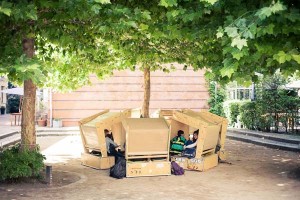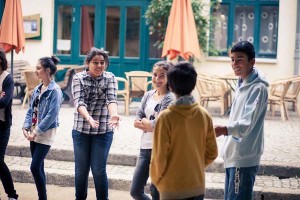Beit is the name of a European project thought up by David Stoleru, a Jewish architect from France. The name refers to the Hebrew word for house “Bajit” as well as to the letter “Bet” of the Hebrew alphabet. Stoleru has designed small timber houses that are somewhat reminiscent of the cozy beach basket chairs common on Germany’s Baltic coast. Seen from the side, they resemble the symbol ב for Bet, the first letter of the word beit. Several classes of eighth-graders set up such houses in the Heckmann Höfe in the Mitte district of Berlin, as a means to temporarily bring into the public sphere their nearby school, whose Hebrew name, Beit Sefer, literally means “House of the Book.” Here, for two days, they devoted themselves to the task of uncovering traces of the Jewish community in the local cultural and urban heritage.
It proved to be a strenuous two days’ work, during which the schoolchildren were almost constantly on the go and often had to push themselves to their limits. They filmed traces of history and asked themselves what these have to do with their present-day lives. They confronted passers-by with their questions about the locality. And they also had to deal with the process of opening up to one another, as one aspect of the project was to promote exchange between Jewish and non-Jewish schoolchildren. The thirteen-year olds found it difficult to work with partners they had only just met. We project supervisors were therefore frequently obliged to split up good friends, so as to give new constellations a chance to develop.
It was always a struggle for the kids to speak to passers-by and get them to agree to an interview. Yet once they had succeeded, they rose to the challenge, assuming their respective roles of camerawoman, assistant, interviewer, and director as a professional team.
And rising to the challenge proved worthwhile: in the Jewish cemetery in Große Hamburger Street, in front of a commemorative plaque for the civilian victims who were buried there in unmarked graves in 1945, the schoolchildren questioned passers-by about the war. One interviewee from Cologne turned out to be a witness to that era, having lived through the Berlin Blitz as a child. Another contemporary witness ran into us in the courtyard of the former Jewish orphanage in August Street. A neighbor, an elderly lady we met in the courtyard, told us about the professional training she received in the building in the 1970s, in what was then East Germany (the GDR).
Those two days of open-air schooling left their mark also on the passers-by. One woman interviewed wrote to us: “Cordial greetings also to your devoted schoolchildren. To meet such young people with such unbridled enthusiasm was a great joy to me.” Our efforts were well worthwhile!
Ariane Kwasigroch, Education
More impressions of the Beit project can be found at http://thebeitproject.org/.
Tomorrow, on Tuesday 24 September 2013, at 5:30 p.m., the closing ceremony of the Beit Project will take place in the Great Hall of the Jewish Museum Berlin (Old Building, second level). A screening of the video-interviews will be followed by a podium discussion between several schoolchildren and the following guests:
Arnold Dreyblatt, artist and musicologist, who works inter alia on the theme of remembering
Regina Scheer, eyewitness, journalist, and author of the book Ahava. Das vergessene Haus (Ahava. The Forgotten House)
Corinna Tell, art historian, and an active member of the not-for-profit association “Denk mal an Berlin e.V.,” where she is responsible for youth projects
The podium discussion will be chaired by Ulrike Wagner, who works at the Jewish Museum Berlin on the project “Vielfalt in Schulen” (Diversity in Schools)
Entrance is free.


We are arriving in Berlin on Oct 6 ,2014 for a week’s vacation. Would it be possible to get a list with addresses of the buildings that were designed by Jewish architects before the war? We will be visiting the museum which we did 2 years ago. Thanks, Judith